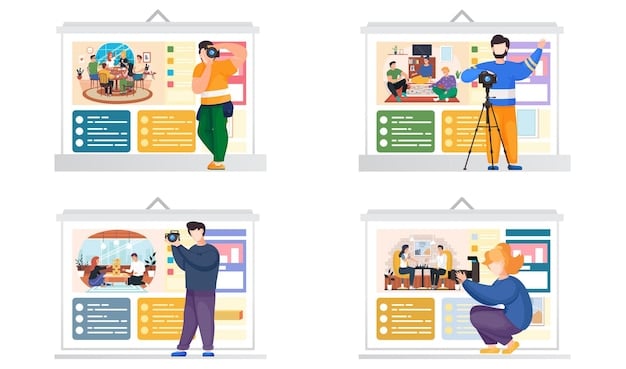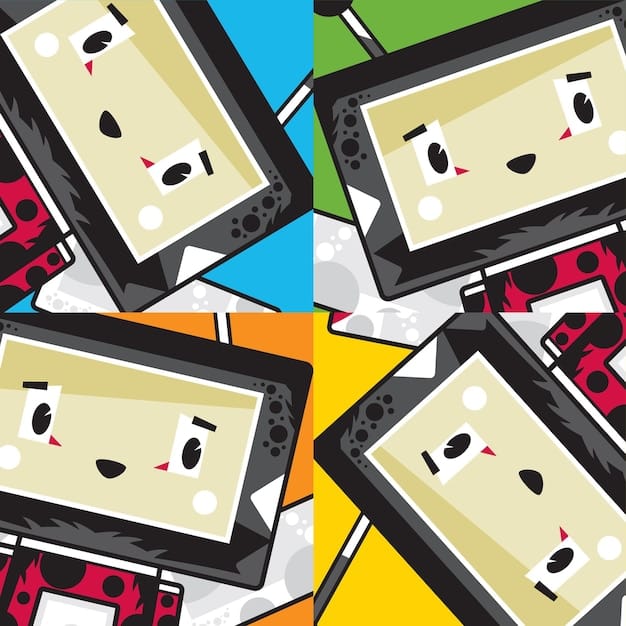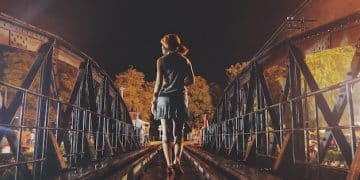K-Drama Webtoons: Discover Original Stories Behind Beloved Adaptations

K-drama webtoons are digital comic series, often colored, that serve as the original source material for many popular South Korean television dramas, offering unique narratives and character developments that frequently translate into hit on-screen adaptations.
Delving into the world of K-Drama Webtoons: Discover the Original Stories Behind Your Favorite Adaptations reveals a rich tapestry of narratives that often precede the beloved on-screen versions. For many K-drama enthusiasts, the journey begins with an enthralling television series, only for them to later uncover that its compelling plot and characters originated in a digital comic format. This exploration not only enriches the viewing experience but also highlights the immense creative potential flowing from webtoons, establishing them as a vital wellspring for Korea’s prolific entertainment industry.
the Rise of Webtoons as K-Drama Goldmines
The landscape of South Korean entertainment has undergone a significant transformation, with webtoons emerging as an undeniable force. What began as a niche digital comic format has swiftly ascended to become a primary source of inspiration for some of the most celebrated K-dramas globally. This phenomenon is not merely a trend but a testament to the robust storytelling and visual appeal inherent in webtoons.
The transition from webtoon to K-drama is a meticulously crafted process. Creators and producers recognize the inherent strengths of webtoons: their established fanbases, pre-tested narratives, and visually compelling aesthetics. This makes them a relatively low-risk, high-reward investment for television studios looking for fresh, engaging content.
the evolution of digital storytelling
Webtoons, or web comics, have distinct characteristics that set them apart from traditional comics. Their vertical scroll format is optimized for mobile viewing, making them incredibly accessible. This accessibility, coupled with vibrant artwork and diverse genres, has fueled their widespread popularity, especially among younger demographics.
- Mobile Optimization: Designed for seamless reading on smartphones and tablets, fostering a strong daily reading habit.
- Full Color: Unlike many traditional comics, webtoons are typically published in full color, enhancing visual appeal.
- Diverse Genres: From romance and fantasy to thrillers and slice-of-life, offering something for every taste.
- Weekly Releases: Consistent updates keep readers engaged and anticipating new chapters.
The narrative structures within webtoons are also uniquely suited for adaptation. Their episodic nature often translates smoothly into the serialized format of television dramas, allowing for natural pacing and character development across episodes. This inherent compatibility streamlines the adaptation process, making it less about invention and more about translation.
from Panels to Production: The Adaptation Process
Adapting a webtoon into a K-drama is a complex undertaking, requiring careful consideration of narrative, character, and visual elements. It involves a delicate balance between honoring the original source material and making necessary adjustments for a new medium and audience. The process often begins with identifying a webtoon that possesses strong storytelling, relatable characters, and high commercial potential.
Once a webtoon is selected, a team of scriptwriters takes on the challenging task of transforming the visual narrative into a script. This often requires expanding subplots, refining character arcs, and adding new dimensions to the story to fit the typical 16-episode K-drama format. Dialogue, which might be sparse in a webtoon, needs to be fleshed out, and visual cues translated into screen directions.
key challenges in adaptation
Despite the advantages, adapters face several hurdles. The visual style of a webtoon, for instance, might be difficult to replicate physically, requiring creative solutions for set design, costume, and special effects. Furthermore, the pacing of a webtoon can differ significantly from a drama, necessitating adjustments to maintain suspense and engagement.
- Visual Translation: Recreating distinct webtoon art styles and fantastical elements within a live-action setting.
- Pacing Adjustments: Modifying the narrative rhythm to suit the episodic nature and runtime of a K-drama.
- Fan Expectations: Balancing fidelity to the original story with creative liberties, while managing ardent fan expectations.
- Character Portrayal: Ensuring actors embody the essence of beloved webtoon characters, often a subject of intense scrutiny from fans.
Successful adaptations often excel at capturing the essence and spirit of the original webtoon, even if specific plot points are altered. They leverage the core strengths of the webtoon—its characters, its unique premise, its emotional depth—and enhance them for the live-action screen. This harmonious blend is what ultimately captivates both loyal webtoon readers and new drama viewers alike.

Iconic K-Dramas That Started as Webtoons
The sheer number of successful K-dramas originating from webtoons is astounding, showcasing the format’s rich narrative potential. These adaptations have not only garnered critical acclaim but have also topped viewership ratings and sparked global fan phenomena. Their popularity underscores the universal appeal of stories first conceived in digital comic form.
One notable example is “Itaewon Class.” This drama resonated deeply with audiences due to its compelling story of resilience, revenge, and ambition. The webtoon’s sharp social commentary and inspiring characters translated seamlessly onto the screen, amplified by stellar performances and a gripping soundtrack. It proved that a strong narrative foundation is key.
a look at top adaptations
Several other K-dramas have also found immense success by drawing from webtoon narratives. These range from heartwarming romances to intense thrillers, illustrating the genre versatility present within the webtoon ecosystem. They highlight different aspects of successful adaptation, from capturing emotional depth to translating intense action sequences.
- ‘True Beauty’: A high school romance focusing on self-esteem and appearances, celebrated for its faithful portrayal of the webtoon’s humor and charm.
- ‘Sweet Home’: A dark, apocalyptic thriller that brilliantly transformed the horrific visuals and intense survival narrative from its webtoon origins into a cinematic masterpiece.
- ‘What’s Wrong with Secretary Kim’: A popular romantic comedy praised for its delightful chemistry and the seamless transition of its witty dialogue and charming characters.
- ‘Business Proposal’: A lighthearted office romance that found immense popularity for its endearing characters and comedic timing, all rooted in its webtoon predecessor.
These examples serve as powerful endorsements for the webtoon’s influence on the K-drama industry. They demonstrate that the journey from a webtoon panel to a K-drama screen can yield immensely satisfying and widely adored narratives, enriching the global entertainment landscape with diverse and compelling stories. The symbiotic relationship between webtoons and K-dramas continues to flourish, bringing forth new masterpieces.
Why Read The Original Webtoon?
For fans who have fallen in love with a K-drama, diving into its original webtoon can be a profoundly rewarding experience. While the dramas offer a captivating visual and auditory experience, the webtoons provide a different, often more intimate, perspective on the stories and characters. This allows for a deeper understanding and appreciation of the narrative’s intricacies.
One primary reason to read the original webtoon is to encounter the narrative in its purest form. Adapters, while striving for fidelity, naturally make creative choices to fit the television format. These may include condensing plots, altering character backgrounds, or streamlining storylines. The webtoon offers the “director’s cut,” as it were, unedited for screen time or production constraints.
deeper dives into character and plot
Webtoons often contain nuances and extended storylines that are omitted or significantly reduced in their K-drama adaptations. Readers can explore side plots, delve into the inner monologues of characters, and witness developments that simply couldn’t make it into a typical drama’s episode count. This richness adds layers to the overall understanding of the universe.
- Uncut Narratives: Experience the full story, including plotlines and character developments not featured in the drama.
- Original Art Style: Appreciate the unique visual aesthetics and character designs conceptualized by the original artist.
- Alternative Endings: Discover nuanced or entirely different resolutions that diverge from the drama’s conclusion.
- Extended Character Backstories: Gain deeper insights into character motivations and histories through additional chapters.
Moreover, reading the original webtoon allows fans to support the creators directly and appreciate the artistry involved in digital comics. It’s an opportunity to connect with the source material on a more fundamental level, observing how a concept blossoms from initial drawings and dialogues into a fully realized world. This journey offers a unique parallel perspective that enriches the entire fan experience beyond the screen.
Navigating the Webtoon World: Platforms and Accessibility
The booming popularity of webtoons has led to the proliferation of various platforms, making these digital comics incredibly accessible to a global audience. These platforms offer a vast library of titles, catering to diverse tastes and preferences. Understanding how to navigate this ecosystem is crucial for anyone looking to dive into the original stories behind their favorite K-dramas.
Leading the charge are platforms like Webtoon (Naver Webtoon) and KakaoPage (Daum Webtoon), which are essentially the Netflix of digital comics. These sites host thousands of titles, many of which have already been, or are slated to be, adapted into K-dramas. They provide user-friendly interfaces, often with English translations, making them welcoming to international readers.
finding your next read
Exploring these platforms often involves using search functions, genre filters, and curated recommendations. Many platforms also offer daily pass systems or subscription models, allowing readers to unlock chapters at their own pace or access premium content. This flexibility ensures that there’s a reading method for every preference.
- Webtoon (Naver Webtoon): Widely popular with a vast library, known for its strong community features and daily updates.
- KakaoPage (Daum Webtoon): Another major player, offering exclusive titles and often a “wait until free” system for popular series.
- Tapas: Features a mix of webtoons and web novels, with a strong focus on community and creator support.
- Lezhin Comics: Known for its mature content and high-quality artwork, often requiring paid access.
Beyond these major platforms, many indie creators also publish webtoons on personal websites or smaller aggregators. These can be hidden gems, offering unique storytelling perspectives that might not make it to mainstream platforms immediately. The ever-expanding webtoon ecosystem ensures that there’s always something new to discover, keeping the source material pipeline for K-dramas consistently full and exciting.

the Future of K-Drama Webtoon Adaptations
The symbiotic relationship between K-dramas and webtoons shows no signs of slowing down; in fact, it appears to be strengthening. As technology advances and global interest in Korean entertainment continues to surge, webtoons are poised to play an even more significant role in shaping the future of K-drama content. This evolution is driven by several key factors, including the continuous innovation in digital storytelling and evolving audience preferences.
The interactive nature of webtoons, with features like comments sections and fan art, fosters strong communities. This direct engagement provides valuable feedback for creators and adapters, influencing plot directions and character developments, even before a drama goes into production. This audience-driven approach can lead to highly resonant adaptations.
emerging trends and innovations
Looking ahead, we can anticipate more sophisticated adaptations that leverage new technologies, such as enhanced CGI and virtual production techniques, to bring even the most fantastical webtoon worlds to life. Furthermore, diversification of genres beyond traditional romance and fantasy is likely, as webtoons explore niche topics and experimental narratives.
- Interactive Elements: Potential for dramas to incorporate interactive fan elements, mirroring webtoon community engagement.
- Global Co-productions: Increased international collaborations to bring webtoon adaptations to a wider global audience.
- Diversification of Genres: Growth in adaptations of less common webtoon genres, such as historical, procedural, and sci-fi.
- Technological Advancements: Use of advanced visual effects to faithfully render complex webtoon visuals on screen.
The future also holds the promise of a more integrated media experience, where fans can transition seamlessly between reading the webtoon and watching its K-drama counterpart. This cross-media consumption blurs the lines between source material and adaptation, creating a holistic entertainment journey. As webtoons continue to innovate and capture imaginations, their influence on the K-drama industry will undoubtedly continue to grow, promising an exciting pipeline of captivating stories for years to come.
| Key Point | Brief Description |
|---|---|
| 📖 Webtoon Origins | Many beloved K-dramas began as digital comics, offering deep narratives. |
| 🎬 Adaptation Process | Transforming webtoons into dramas involves complex scriptwriting and visual translation, balancing fidelity with new medium demands. |
| ✨ Deeper Immersion | Reading original webtoons provides extended storylines, character backstories, and unique art styles often absent in adaptations. |
| 🌐 Accessibility | Platforms like Webtoon and KakaoPage make vast libraries of translated webtoons accessible globally. |
frequently asked questions
▼
A webtoon is a digital comic optimized for vertical scrolling, primarily originating from South Korea. Many popular K-dramas are direct adaptations of these webtoons, translating their compelling storylines, characters, and concepts from the digital comic format to live-action television series, leveraging their existing popularity and rich narratives.
▼
Webtoons offer a pre-verified audience and proven storytelling concepts, reducing the risk for producers. Their episodic nature and strong visual appeal translate well to the drama format. Additionally, webtoons provide a constant pipeline of fresh and diverse narratives, allowing K-drama creators to continually innovate and produce engaging content for a global audience.
▼
While many adaptations strive for fidelity, creative liberties are often taken to fit the television format. These adjustments might include condensing subplots, altering character traits, or modifying endings to suit runtime, budget, or audience expectations. Fans often read the original webtoons to discover these nuanced differences and experience the story in its full, unaltered form.
▼
Several major platforms offer English translations of popular webtoons. The most prominent include Webtoon (formerly Naver Webtoon), KakaoPage (owned by Kakao Entertainment, which also runs Daum Webtoon), Tapas, and Lezhin Comics. These platforms provide official translations and user-friendly interfaces, making it easy to discover and read the original stories.
▼
Many widely acclaimed K-dramas began as webtoons. Notable examples include ‘Itaewon Class,’ lauded for its strong character development; ‘True Beauty,’ celebrated for its relatable high school narrative; ‘Sweet Home,’ known for its thrilling horror adaptation; and ‘What’s Wrong with Secretary Kim,’ a beloved romantic comedy. These demonstrate the versatility of webtoon source material.
conclusion
The journey from webtoon to K-drama is a testament to the power of compelling storytelling and the dynamic evolution of entertainment media. What began as an accessible digital comic format has blossomed into a vital wellspring for South Korea’s globally acclaimed television industry, offering narratives that are both deeply resonant and visually captivating. For enthusiasts, uncovering the original webtoons not only enriches their appreciation for their favorite dramas but also opens up an entire universe of fresh, unadapted stories waiting to be discovered. This symbiotic relationship ensures a continuous flow of creative content, pushing the boundaries of what is possible in both digital comics and on-screen narratives, solidifying the webtoon’s integral role in the future of Korean entertainment.





